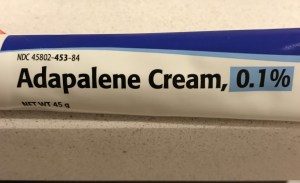One of the tell-tale signs your child is starting puberty is the emergence of little pimples on their face. Of course this is assuming they aren’t advertising the other bodily changes that are taking place. Parents may notice changes in their child’s skin as early as 10 years of age and since acne can last well into the late teens, it’s good to get started on healthy skin habits as soon as the pimples appear.
Before we get to treatment options, let’s review what acne is and why we see it in teens.
ACNE is the most common skin condition seen in the United States and consists of multiple types of blemishes. These blemishes occur at a time when hormones released during puberty cause increased sebum production by oil glands. This excess oil, in conjunction with bacteria and dead skin cells, clog the pores.
- Blackheads are plugs in the pore that are close to the surface. The pore is open so dead skin cells and skin pigmentation are seen.
- Whiteheads are plugs that are deeper in the skin and can vary from small bumps to red irritated bumps to pustules (pus comes to the surface).
- Cysts are very deep, creating a large, often painful, bump or nodule.
Why treat acne?
While acne may appear to be a superficial condition, it can actually have longstanding consequences. On the skin, the most common complication of acne is scarring and dark spots. Scars typically form after having deeper nodules. Scars also form from picking, so DON’T PICK! Acne can also cause dark spots on the skin which, like scars, can persist into adulthood. More serious complications of acne are low self-esteem and depression. Some teens have such severe acne that they don’t want to go to school and some even consider suicide.
What are treatment options?
Treatment of acne will vary as the acne itself will change throughout adolescence. The treatment will also depend on the severity of the acne. Very mild acne, which we might see in younger teens and tweens, is best treated with mild medications that help layers of skin peel off and break open the pimples. These medications can be found over the counter.

OTC benzoyl peroxide (BPO) or salicylic acid are easy to find and often well tolerated, although a small number of people may be allergic to the BPO. If you find that after 6-8 weeks these treatments are not working or the acne is getting worse, it may be time to move on to prescriptions.
- Retinoids work by accelerating skin cell turnover, reducing the amount of dead skin cells, which clog pores. They also help to break up existing pimples. Common retinoids include Retin A and Differin. (Adapalene, generic for Differin, is a well tolerated retinoid and is now available over the counter.)

- Topical antibiotics kill the bacteria on the surface of the skin. Signs of bacterial involvement may be pimples that are red and inflamed or have pustules. Because of antibiotic resistance, this is best saved for acne in which other treatments don’t work. It is also necessary to use topical antibiotics in conjunction with topical BPO.
- Oral antibiotics are very helpful when deeper, inflamed nodules and cysts are present. They can also help clear up acne that is present on the chest and back. Use of oral antibiotics needs to be done in conjunction with topical BPO as well, and should be re-evaluated every 3-6 months. It’s best to have treatment options to fall back onto once oral antibiotics have helped so that they can be easily removed.

- Accutane is oral acne medication called isotretinoin. It has a lot of side effects and should only be used in severe cases of acne and should be prescribed by a dermatologist.
- Birth control pills are very helpful in girls because the hormone in the pills reduce the hormones in the body that increase sebum production. This is a good option for older teen girls who need to be weaned off of oral antibiotics.
What are the side effects of treatment?
Acne medications can cause dryness, redness and sun sensitivity. Therefore, it is very important to follow your doctor’s directions. These usually include allowing the face to dry for 20 minutes before applying medication, starting treatment every other night and gradually building up to nightly, moisturizing, and wearing sunscreen every day. Furthermore, if you are prescribed oral antibiotics, do not take them right at bedtime and be sure to take them with a large glass of water. The pills can get stuck in the esophagus and cause irritation. Finally, don’t wash more than twice per day, clean the skin after sports or sweating, and don’t pop the pimples.
I haven’t seen any consistent data on the relationship between specific foods in the diet and acne. Some people believe that dairy products or other foods make their acne worse. Teens are growing and need all the categories of food and a variety of nutrients, so if you feel you need to cut certain types of foods out of the diet because of acne, please talk to your doctor first. It may be safer to use some acne medication instead of cutting out nutrition. As always, a diet rich in fruits, vegetables, whole grains, calcium and lean protein is best for the whole body, including the skin. And don’t forget to drink lots of water!



